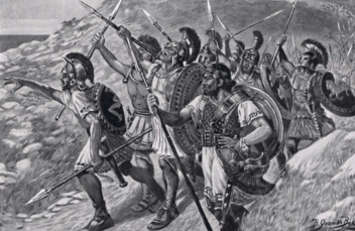As the nation asks whether the end really is in sight for the journey to airport expansion in the South East, we take a trip back in time - from the late sixties to the fifth century BC - to highlight some of the greatest long, prelonged, and generally quite tortuous journeys of history.
Top 5 great historical journeys:
1) Fly me to the moon – and back!
We’ll start with a relatively recent one, but no less historical for that and the furthest humanity has ever gone to take one small step. In May 1961, US President John F Kennedy told a joint session of Congress: ‘This nation should commit itself to achieving the goal, before this decade is out, of landing a man on the moon and returning him safely to the earth’.

Bernard Granville Baker's painting of the the Anabasis' returning Greeks
Sadly, Kennedy was not around to see Apollo 11 reach the moon just before the end of the decade in July 1969. Neil Armstrong and Edwin ‘Buzz’ Aldrin set foot on the moon and had a bounce around in its low gravity conditions. They also returned safely, as did the crew of a further six Apollo missions, including Apollo 13 (bad idea), whose crew had to abandon the lunar landing after an oxygen tank exploded.
2) Fly me to Connemara
In June 1919 British aviators John Alcock and Arthur Brown made the first non-stop transatlantic flight when they flew a modified First World War Vickers Vimy bomber from St. John's, Newfoundland, to Clifden, Connemara, County Galway, Ireland.
Winston Churchill, the then secretary of state for Air, presented them with the £10,000 Daily Mail prize. A small amount of mail was carried on the flight, making it the first transatlantic airmail flight too.
Eight years later, in May 1927 Charles Lindbergh flew the 'Spirit of St Louis' from the dirt runway of Roosevelt Field, Long Island 3,500 miles to Paris, becoming the first person to fly the Atlantic solo. A further five years later Amelia Earheart became the first woman to fly solo non stop across the Atlantic.
3) Doctor Livingstone, I presume?
We’re too modest to point out that one of the great journeys of history was by a journalist. In 1864 Scottish explorer David Livingstone mounted an expedition through central Africa with the aim of discovering the source of the Nile. As years went by, little was heard from the him and rumours spread that he was being held captive or was lost or dead. Newspapers asked ‘Where is Livingstone?’ and in 1871 George Bennett, publisher of the New York Herald, commissioned reporter Henry Stanley to find Livingstone.
Leading an expedition of approximately 200 men, in March 1871 Stanley made an anabasis from the eastern shore of Africa into the interior of the continent. After nearly eight months he found Livingstone in Ujiji, a small village on the shore of Lake Tanganyika, and uttered the famous line…
4) Across the Alps with elephants
The crossing of the Alps in 218 BC by Carthaginian general Hannibal is one of the most celebrated achievements of any military force in ancient warfare. Bypassing the Roman's land garrisons and naval dominance, Hannibal led his Carthaginian army over the mountains and into Italy to take the war directly to the Romans.
What makes Hannibal’s epic journey remarkable is that he did it with 37 war elephants, as well as 90,000 soldiers and 10,000 horses. His actual route across the Alps has been debated for centuries, although the recent discovery of a ‘mass animal deposition event’ has led some archaeologists to think they may have solved the mystery.
5) The Sea! The Sea!
Going even further back into the time (and myth), ‘Thalassa! Thalassa!’ is what 10,000 roaming Greek mercenaries shouted when they saw the Black Sea from Mount Theches in Trebizond, after participating in Cyrus the Younger's failed march against the Persian Empire in the year 401 BC.
Xenophon, an Athenian nobleman, warrior and writer, was one of the ten thousand and told the whole story in The Anabasis -'one of the great adventures in human history'. For the sea-faring Greeks, finding their way back to the sea meant home. They could build ships and sail to safety (but didn't).
Register now for full access
Register just once to get unrestricted, real-time coverage of the issues and challenges facing UK transport and highways engineers.
Full website content includes the latest news, exclusive commentary from leading industry figures and detailed topical analysis of the highways, transportation, environment and place-shaping sectors.
Use the link below to register your details for full, free access.
Already a registered? Login